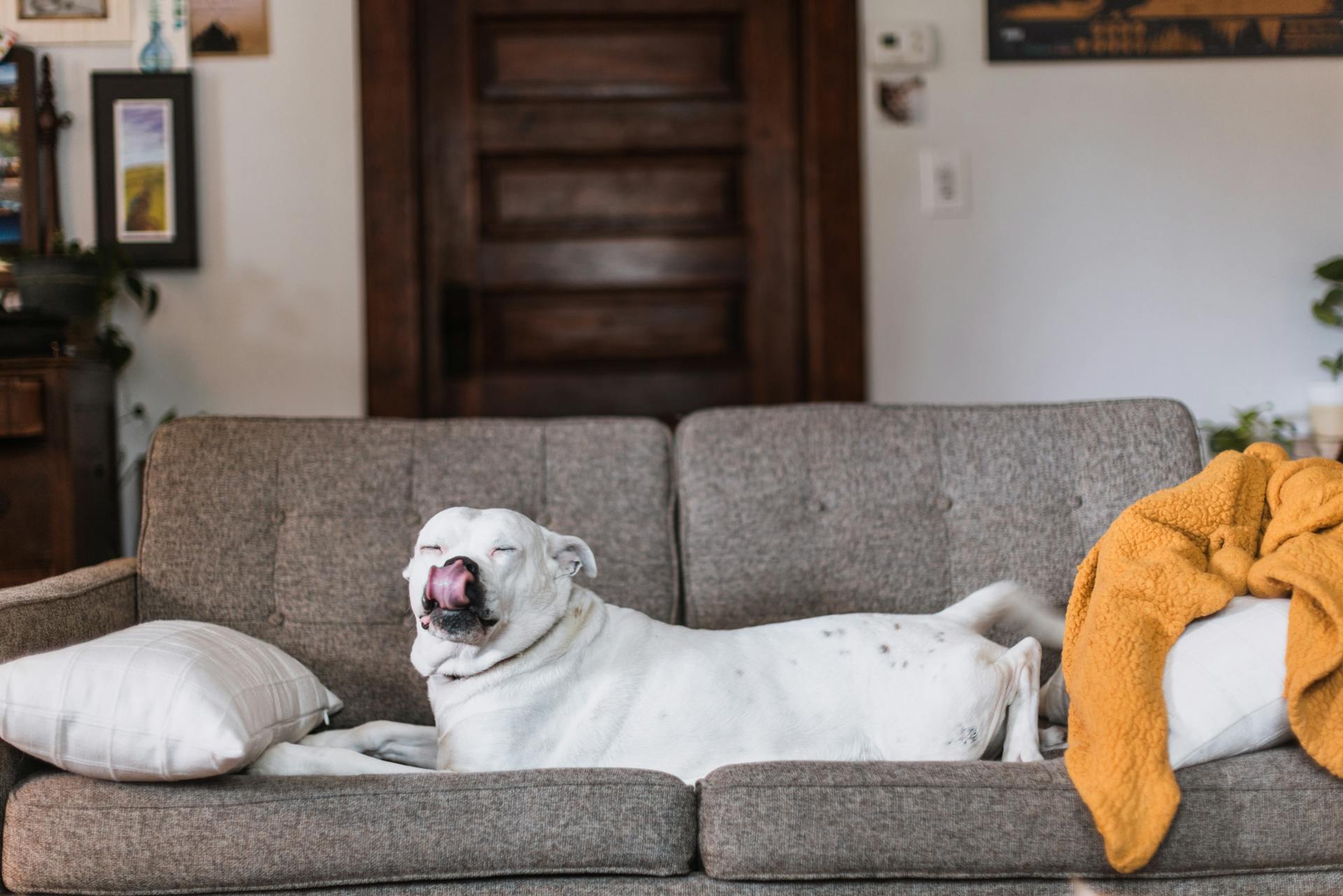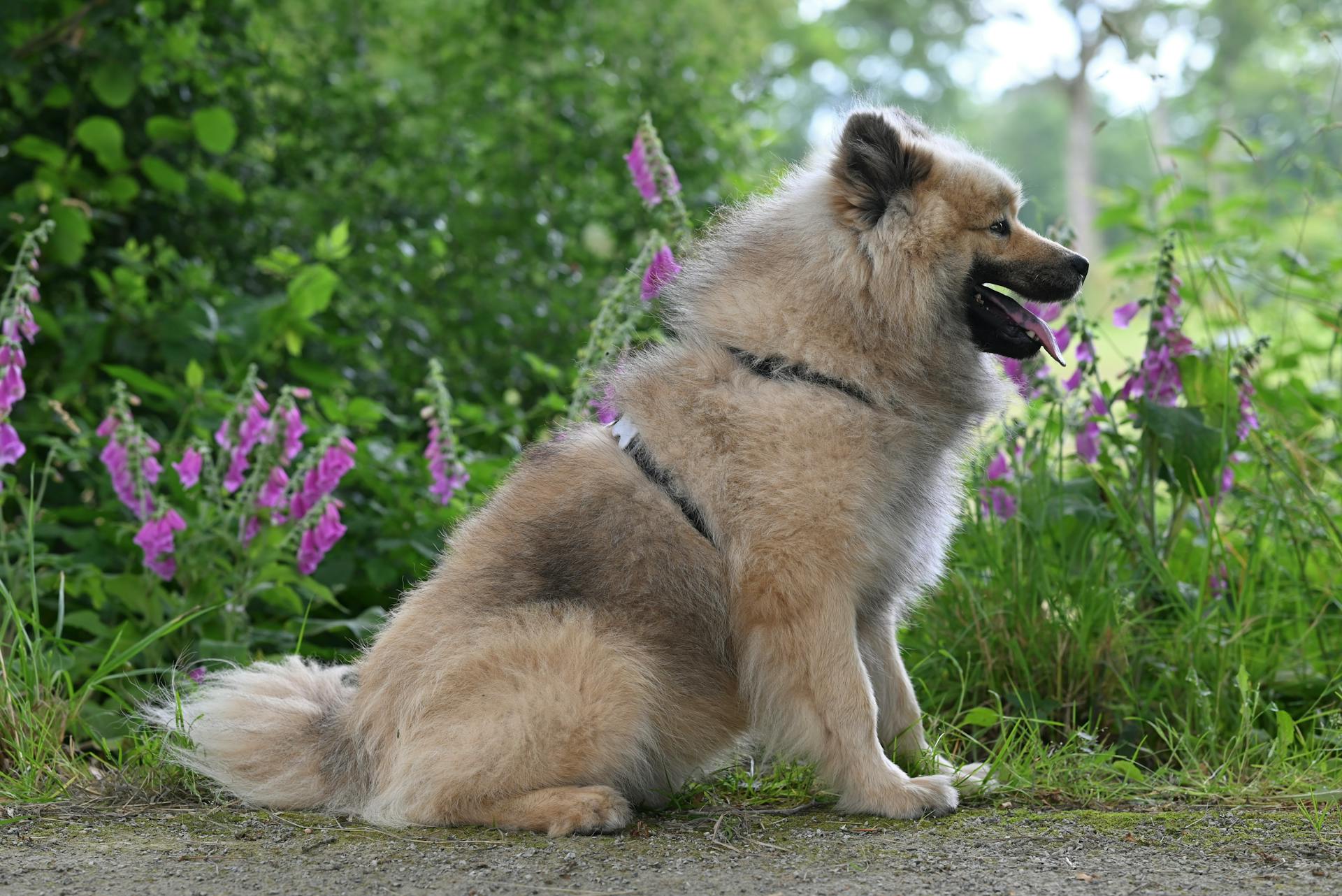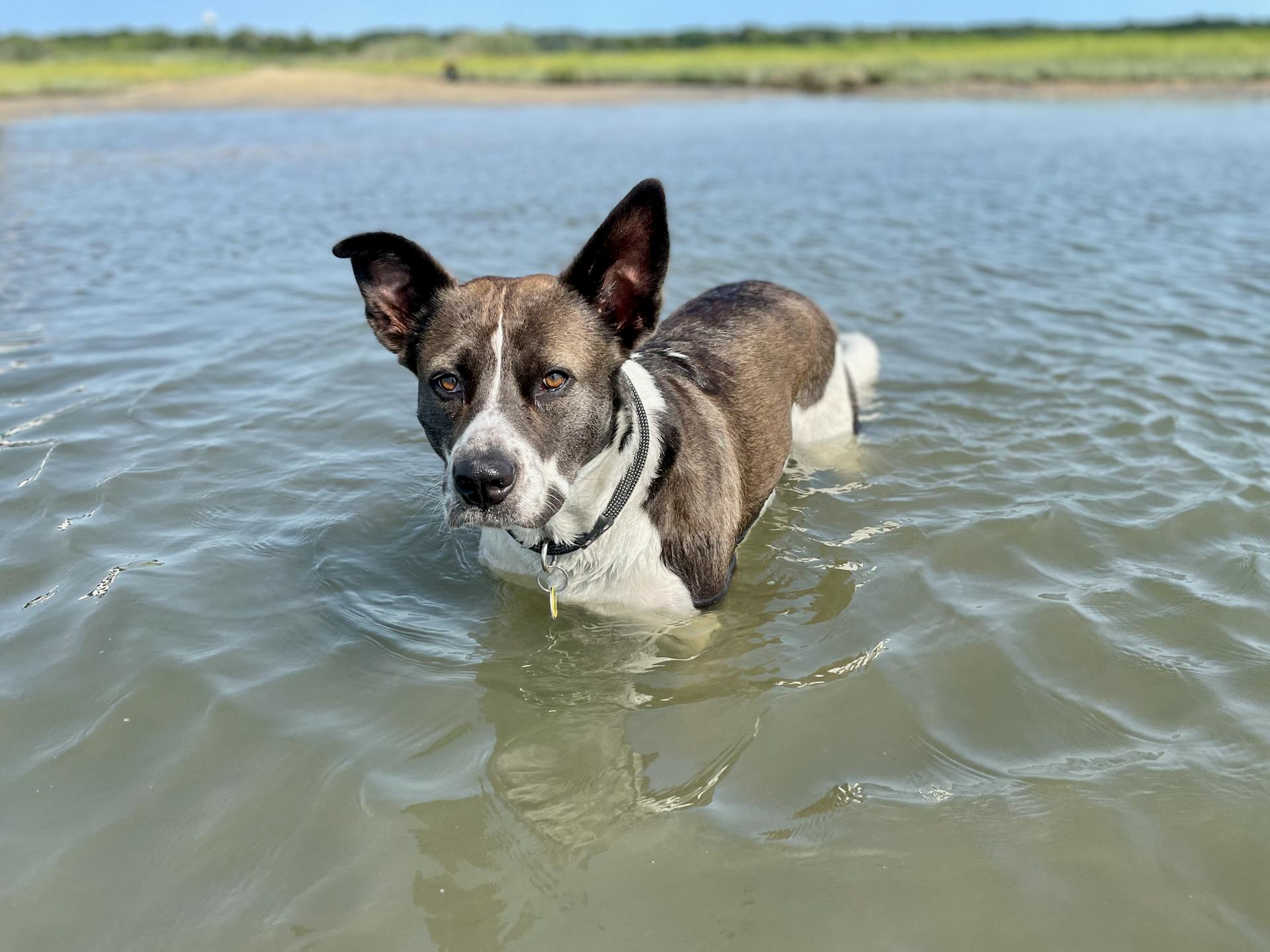
Canine massage is a holistic approach to improving your dog's physical and emotional well-being. Regular massage sessions can help reduce muscle tension and inflammation.
By releasing tension in the muscles, massage can also improve your dog's range of motion and reduce pain. This is especially beneficial for dogs with arthritis or other mobility issues.
Massage can also have a positive impact on your dog's mental health, reducing stress and anxiety. In fact, studies have shown that massage can lower cortisol levels in dogs.
Regular massage sessions can also help improve your dog's overall health and well-being, leading to a happier and healthier companion.
History of Canine Massage
The history of canine massage is a fascinating one. It dates back to ancient times in India, where varmalogy, a practice that charted both human and animal bodies, was developed, resulting in the identification of trigger points.
Julius Caesar was known to travel with a personal massotherapist who worked on his war dogs. This shows that even in ancient times, people recognized the benefits of massage for animals.
The first known documentation of massage was in 2700 BC in China, where massage techniques were mentioned in early writings. Early Egyptian hieroglyphics even depicted "animal healers" using massage techniques.
In the West, Swedish massage was the most common form of massage used, developed by Per Henrik Ling. It was first brought to the U.S. by Dr. Weir Mitchell in 1877.
The benefits of massage for animals, particularly horses, were recognized during World War I and World War II. Modern massage was primarily used for horses until the late 20th century.
Benefits and Effects
Canine massage is a wonderful way to improve your dog's overall health and well-being. It can be used for relaxation, rehabilitation, or competition purposes, and the benefits are equivalent to those experienced by humans.
Massage can help relieve age-related problems, such as muscle atrophy from inactivity or disuse. It can also provide relief from muscle tension, soreness, spasms, and weaknesses.
Additional reading: Muscular System Dog Muscle Anatomy
One of the most significant benefits of canine massage is its ability to reduce stress and anxiety in dogs. By promoting relaxation and releasing tension in the muscles, massage can help calm hyperactivity, anxiousness, and nervousness in dogs.
Massage can also improve joint mobility and increase circulation to affected areas, making it an effective treatment for arthritis. This is especially helpful for older dogs who may develop this condition.
In addition to its physical benefits, massage can also stimulate the digestive system and alleviate discomforts such as constipation or an upset stomach.
Here are some specific benefits of canine massage:
- Relieves age-related problems
- Reverses muscle atrophy from inactivity or disuse
- Provides relief from muscle tension, soreness, spasms, and weaknesses
- Relieves chronic pain and discomfort from arthritis, hip dysplasia, etc.
- Treats myofascial pain
- Reduces stress and anxiety
- Decreases pain
- Improves circulation and lymphatic flow
By incorporating massage into your dog's daily routine, you can provide a comforting form of relaxation and improve their overall health and well-being.
Techniques and Methods
Canine massage is a holistic approach that utilizes various techniques to promote relaxation, reduce pain, and improve overall well-being. These techniques include Swedish Massage, Myofascial Release, and Positional Release, among others.
Many of these techniques share similar strokes, but the application of these strokes may vary depending on the intent of the stroke and the practitioner's skill level. For instance, Swedish Massage is known for its long, flowing strokes and muscle kneading, while Myofascial Release targets the connective tissue covering the muscles.
Some common massage techniques used in canine massage include Reflexology, which focuses on pressure points in the paws and ears, and Trigger Point Therapy, which targets specific pain points for immediate relief. These techniques can be used in combination to provide a comprehensive massage experience.
Here are some specific massage techniques for various areas of the body:
- Neck and shoulders: use circular motions and long strokes to relieve tension
- Back and spine: place hands on either side of the spine and move along the length of the body, avoiding direct pressure on the spine
- Legs and paws: be gentle and attentive, using a lighter touch
- Belly and chest: use long, sweeping strokes, which can be soothing for stressed or anxious dogs
The massage therapist will assess the dog's gait and posture, perform a superficial palpation, and review the dog's medical history before beginning the session. This helps the therapist identify areas of tension and create a personalized massage plan.
Techniques
Techniques used in canine massage are similar to those used in human massage, including Swedish Massage, Myofascial Release, and Trigger Point Therapy.

Many canine massage techniques share basic strokes, but the application of these strokes may vary depending on the intent of the stroke and the practitioner's skill level.
Some techniques, like Swedish Massage, use long, flowing strokes and muscle kneading to relax the dog's muscles.
Myofascial Release targets the connective tissue covering the muscles, while Positional Release involves putting the dog's body in comfortable positions to encourage muscle relaxation.
Reflexology focuses on pressure points in the paws and ears that correspond to different body systems.
Watsu, a form of water therapy, is an excellent technique for dogs with severe joint issues.
Acupressure uses pressure on specific points to stimulate the dog's natural healing abilities.
Here are some specific massage techniques for various areas of the dog's body:
Applying Human Techniques to AI
Applying human techniques to AI can be a bit tricky, just like adapting human massage techniques to suit a dog's unique anatomy.
While some principles are similar, human techniques should be adapted to suit the unique needs of AI systems.

Human intuition and experience can be valuable in developing AI, but AI requires a more structured and systematic approach.
Just as human massage techniques need to be modified for dogs, human techniques for problem-solving and decision-making need to be translated into a language AI can understand.
This involves breaking down complex tasks into smaller, more manageable parts, just like a dog's unique anatomy requires a tailored massage approach.
Check this out: Just Food for Dogs Renal
Procedure
The massage therapy procedure for dogs is a thorough and non-invasive process. The therapist begins by assessing the dog's gait and posture.
A superficial palpation is then performed to detect any skeletal or muscular abnormalities underneath the skin's surface. This helps the therapist identify potential areas of concern.
The therapist will review the dog's medical history records and consult with the dog owner about previous injuries and surgical procedures. If no records are available, the therapist will ask the owner about the dog's medical history.

The massage therapy session typically lasts around 30 minutes to an hour, with longer sessions for first-time patients. The therapist may use a cushioned standing table or a mat on the floor, depending on the dog's abilities.
After the session, the therapist will provide a detailed diagrammatic feedback to the dog owner, highlighting any painful areas and areas with limited motion. The therapist may also make at-home recommendations and demonstrate simple massage techniques for the owner to perform at home.
See what others are reading: How to Get Dog Odor Out of Room
Preparation and Safety
Before you start giving your dog a massage, it's essential to create a calm and quiet environment. This will help your dog relax and make the massage more effective.
Choose a time when your dog is already relaxed, such as after a meal or before bed. This will increase the chances of a successful massage session.
If your dog is touch-averse, it's crucial to introduce them to the idea of being touched gradually, especially in sensitive areas.
To ensure a safe and enjoyable experience for your dog, consider the following safety precautions:
- Don't give massages to dogs with a fever, an infection, or a recent injury.
- Watch out for signs of discomfort or distress, such as pulling away, growling, or stiffening of the body.
- Consult your vet before starting a new massage routine, especially if your dog has a chronic illness or injury.
By taking these simple steps, you can create a positive and relaxing experience for your dog.
Frequently Asked Questions
How do you properly massage a dog?
To properly massage a dog, use the flat part of your fingers or thumbs to gently massage their muscles, starting with their front feet. Begin with gentle strokes and gradually increase pressure as needed, always being mindful of your dog's comfort and boundaries.
Where does a dog like to be massaged?
Dogs typically enjoy being massaged on their back, belly, and areas around their neck and shoulder blades, where gentle circular motions can be applied. Massage these areas to help your dog relax and feel comfortable.
What is dog massage called?
Canine massage is also known as Canine Merishia Massage, a soft tissue therapy that eases pain and improves mobility in dogs.
Sources
Featured Images: pexels.com


